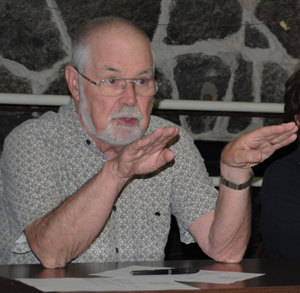IFPD Mutual Aid calls top $3 million in 2024
At the November 12th meeting of the Board of Commissioners of Idyllwild Fire Protection District, Chief Mark Lamont’s Report noted invoicing of Mutual Aid calls over $3.6 million for 2024, not including participation in the Mountain Fire in Ventura County. In 2020 mutual aid calls amounted to $500 thousand, and this year is well above 2022’s $2 million. Speaking about budgeting, he said that he is not planning on this trend continuing. Indeed, past budgets do not include Mutual Aid income because it is unknown. Financial year 2024-2025’s total income was estimated at just over $3.5 million.
LaMont shared that he had learned how to fight wildfires working with Ventura County Fire, and was familiar with the terrain where the Mountain fire was burning.
He spoke of stages in the response: anchoring, (finding a safe place to begin the fight) flanking, (restricting sideways growth of the fire) and finally seeking cut off points that will contain the growth, “Rivers, Ridges and Roads,” features that represent opportunities for firefighters to head off a fire.
LaMont said that the loss of 200 structures during the Mountain Fire, many of which were older, demonstrated the importance of strict building codes, including sprinkler requirements. Sprinklers are now required in California in all new residential construction. LaMont noted that newer systems are activated one head at a time, so a kitchen fire will not flood the entire house. In response to a question from Commissioner Stephanie Yost, he explained that houses are often unscathed after a fast-moving fire front passes through the surroundings, but secondary sources like wood piles on the outside and curtains on the inside bring the fire into the structure, and sprinklers help with this, freeing up fire fighters to deal with the larger fire.
`LaMont told the board that the District’s Crew 621 has been in demand, including action on the Line Fire, and has been upgraded from Type II to Type II IA. “IA” stands for “Initial Attack,” and means they are self-sufficient during the early stage of wildfire response and can be broken into independent squads.
He called attention to the USFS Partnership Agreement signed this last year. It allows IFPD to shoulder some of the burden of the understaffed federal agency. IFPD is reimbursed for work they do both proactively and responding to incidents on federal land. This may include “re-entry” work to clean up regrowth on our local fire breaks.
LaMont encouraged calls to congressional representatives to raise the pay of USFS firefighters: he said that currently a USFS Battalion Chief working in California is paid $58 thousand, while municipal Chiefs earn an average of $178 thousand. He said that the Forest Service’s annual “Fire Hire” event, held in October had the lowest response rate ever. “Seats are not being filled.”
The Chief said that this year’s nearly $1 million grant from the state will be disbursed in early 2025 and residents will see that money going to work in the first quarter. The largest intended purchase is a masticator that will greatly speed up fuel’s reduction projects. Since highways and main roads are fire breaks, we can expect to see IFPD’s crew working there, as well as on projects like the new Bear Trap fuel break.
Ambulance operations continue to be an expensive job for IFPD. Each financial report shows the discrepancy between billing and payments. The district provides over 450 trips per year, an average of more than once a day, but often grouped together on busy weekends so that sometimes there are eight to ten in a single day. These trips are all over 100 mile around trip, much longer than the national average. Each trip takes two employees at least three hours. Since July, IFPD has billed over $358 thousand and been paid less than $100 thousand, 28%.
Idyllwild Fire responds to calls in Pine Cove, Lake Hemet, and Anza. They have an arrangement with Anza’s Hamilton High, to have an ambulance on site for every football game. IFPD is paid for this, and the school saves on insurance. The Chief noted that IFPD and Cathedral City Fire are the only districts in the county to still provide ambulance service.
LaMont explained the difference between BLS (Basic Life Support) and ALS (Advanced Life Support), and the lucrative models that for-profit medical transport companies use. With “basic” service a provider can swipe a card and take payment at the time service is rendered, but “advanced” calls must be billed. LaMont added that Executive Assistant Rachel Teeguarden has taken the classes to do this medical transport billing, saving the district $50,000 per year.
LaMont described the contract that American Medical Response (AMR, now owned by Global Medical Response, GMR) has with the county. They agree to take ALS trips, but are granted a monopoly on BLS calls, which represent 80% of calls and are short and relatively easy, often transporting patients from one facility to another.
This month’s financial statement included an employee bonus the board had been talking about for most of this year: ten employees received $5,000 each.
The board approved a Local Hazard Mitigation plan, a formality necessary to receive any federal funds from FEMA. The plan was dated January 2023 but has been in review since then and is intended to cover the next year. It “checks a box” on grant applications. It is a primer on our community’s assets and vulnerabilities, and IFPD’s organization and strategies including capital improvements, mitigation plans and funding streams.
The board packet included two letters from SDRMA (Special District Risk Management Authority.) LaMont noted that the District has 1,300 contacts with he public each year, and has had no property/liability or workman’s comp claims paid out in six years. LaMont quantified the District’s safety record. When Districts join the SDRMA they enter the pool of insured with an Experience Modification Factor (EMOD) of 100. After two years without a claim the score is lowered to 95, and so on. IFPD is now at 70. Some agencies, he said, are at 135, and an agency is removed from the pool at 140. LaMont told the board that the savings on insurance from this low rating are worth $300 thousand, six times the bonuses paid out this month.
The meeting went into a closed session to evaluate Chief LaMont’s performance. Commissioner Sawicki reported by text that the board continued in closed session until 6:18 and gave LaMont an “exemplary” rating.
The next regular meeting of the board is scheduled for January 28.




